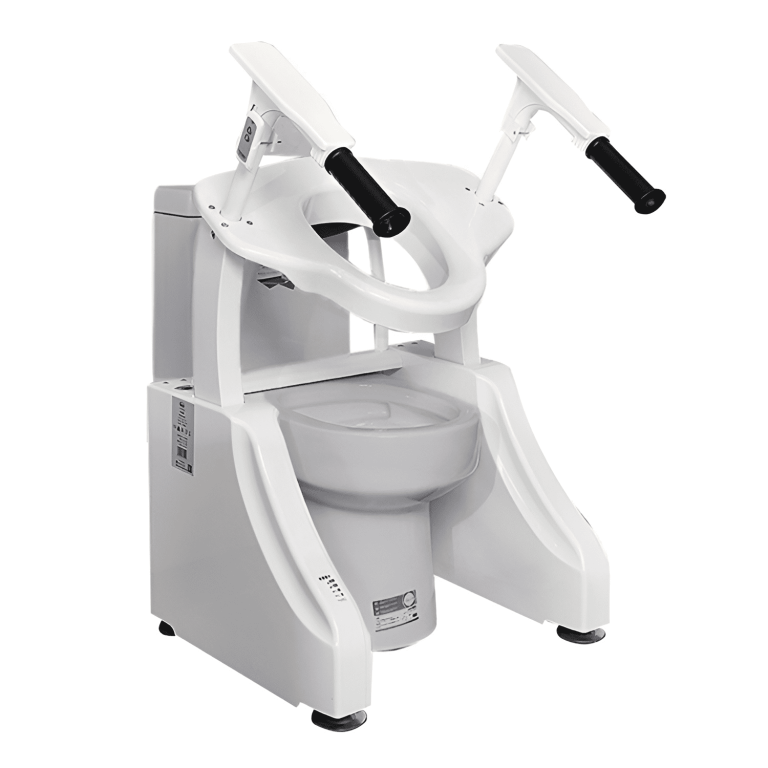Medical Toilet Seats
MEDICAL TOILET SEATS adds extra height to the toilet, minimizing the amount of bending required to sit on it.
People with limited muscle strength or balance may find bending too far over to use the toilet dangerous. In addition, these seats are ADA-compliant.
The height of these seats also varies, depending on the individual’s needs.
- ELEVATED TOILET SEAT RISER – This essential medical supply raised toilet seat is designed to provide added height and support for those with mobility issues or who have difficulty using a standard toilet. It raises the seat by 3.5 inches, making it easier to sit down and stand up.
- PADDED ALUMINUM ARMS – The riser features sturdy aluminum arms that are padded for comfort and support while using the toilet. The arms provide stability and can assist with balance when standing up or sitting down.
- COMPATIBLE WITH ONLY ELONGATED TRADITIONAL STYLE TOILETS – This raised toilet seat is designed exclusively for elongated traditional style toilets, measuring 19 x 14 inches. It will not fit european modern design one-piece toilets without back screws. PLEASE MEASURE YOUR TOILET BEFORE PURCHASING AND REFER TO IMAGES WITH DIMENSIONS FOR ADDITIONAL INFORMATION.
- SAFETY AND EASE OF USE – The raised toilet seat riser provides a safer and more comfortable bathroom experience for seniors, individuals with disabilities, or anyone who may have trouble using the toilet. It features a molded base with included pads under the riser to prevent slipping when in use.
- HIGH QUALITY CONSTRUCTION – Made from durable materials, this elevated toilet seat riser is built to last. Its lightweight yet sturdy design can support up to 300 pounds of weight capacity. It includes all parts and hardware to install the riser under your existing elongated toilet seat.
Last update on 2025-10-27 / Affiliate links / Images from Amazon Product Advertising API
Medical toilet seats are used to reduce the distance a person bends to sit on the toilet.
Seniors with physical limitations often have difficulty getting on and off the toilet.
Medical toilet seats minimize the amount of time a person has to bend to sit on the toilet. This increases comfort and safety.
With the seat elevated several inches, the user no longer has to bend as far to reach the seat.
A higher seat also makes it easier for the user to stand up from the toilet.
A raised medical toilet seat is a simple and effective way to make the toilet experience more comfortable for people with limited mobility.
It can be attached to a standard or elongated toilet, reducing the amount of bending required to sit down on the toilet.
Some raised seats are equipped with handles, arms, or other features to make the toilet more stable for people with limited mobility.
They can help people recovering from hip replacement surgery.
For most people recovering from hip replacement surgery, a high-elevation toilet seat is a great way to make getting on and off the commode easier.
While it might sound strange, a soft-padded toilet seat can reduce pain and make it easier to clean yourself.
A bedside commode may be uncomfortable due to increased swelling and difficulty wiping. An adjustable toilet seat or a wider commode may alleviate these problems.
Also, a raised toilet seat will prevent you from feeling pressure on your incision site while you’re sitting down or standing up.
Whether you need a posterior or lateral hip replacement, there’s a medical toilet seat to fit your needs.
If you need a more complicated model, you can find one that’s powered by electricity and allows you to select a temperature for your water.
Many medical toilet seats are affordable and compatible with most standard toilets.
While you’ll probably need to stay off of your feet for about 6 to 10 weeks after hip replacement surgery, a raised toilet seat can help you avoid re-injuring your hip.
Medical toilet Seats come in a variety of heights.
Getting a medical toilet seat is one way to ensure a safe and secure fit. These seats are available with or without arms and are attached to bolts on the back of the toilet seat.
If your patient has difficulty with balance, you may want to consider a separate toilet rail or grab bar.
A comfortable toilet seat is at least 17 inches above the regular toilet. It can make the process of constipation easier for someone who has a lower body height.
Some toilet seats are just plain ugly. While comfort height toilets are popular, they’re not suitable for everyone. If you’re unsure, try sitting on one before purchasing.
Choosing a toilet that’s too high for you may result in poor flushing performance and lower overall satisfaction.
Last update on 2025-10-27 / Affiliate links / Images from Amazon Product Advertising API
Medical toilet seats should be ADA-compliant.
To be ADA-compliant, medical toilet seats must be designed to meet specific requirements.
This can include providing a minimum 30-inch by 48-inch space for access to the sink and toilet. Toilet seats should not have a door that swings into this space.
The centerline of the seat must be between 16 and 18 inches from the sidewall and the rear wall.
Additionally, a wheelchair must be able to turn in the required space. This space also includes a toilet seat that is at least 17 inches in height.
The water closet should be 17 to 19 inches above the floor to be ADA-compliant. The flush valve should not require a tight grasp, pinching, or twisting of the wrist to function properly.
Grab bars should extend 33-36 inches from the rear and side walls and be at least 1.5 inches from the floor. They should also be durable enough to hold 250 pounds of pressure.
These ADA-compliant toilet seats and accessories are designed to meet these requirements.
They are portable
There are two types of medical toilet seats.
One is stationary, while the other is portable.
These types are often referred to as mobility toilet seats.
Mobility toilet seats help people with limited mobility to use the bathroom easily. A commode chair is a portable toilet that Medicare Part B usually covers.
Medicare covers medical toilet seats as DME, which is a type of medical equipment. Some plans also cover portable toilets.
The first type is called a raised toilet seat. This type of seat is much like a commode booster seat.
It installs under the current toilet seat and raises it to 3.5 inches.
The second type is portable and can be placed on top of the toilet when necessary. Portable toilet seats feature contoured plastic seats with non-skid padding.
The portable version is easy to install and remove. The two types are similar but different.
Medical toilet seats can be more expensive.
Luckily, there are affordable options for those who need a higher toilet seat. A 3-in-1 bedside commode can be purchased and installed over the toilet.
The medical toilet seat has legs and can be used as a shower chair or bedside commode.
These seats are made of lightweight, durable polyurethane foam with a sturdy aluminum frame.
They are easy to clean and don’t cost much to install.
Toilet safety seats are designed to offer additional support for a patient.
They can be temporary or permanent fixtures. People with limited mobility and flexibility may experience falls.
A raised toilet seat can make the task much easier and improve daily life. This product is affordable enough for most people to use. The main concern is security.
Once a person falls, their chances of getting hurt are much higher.









